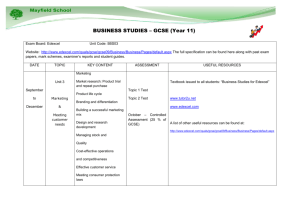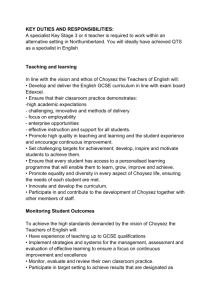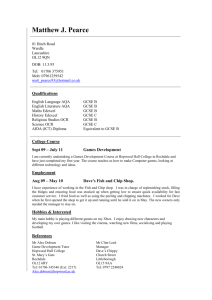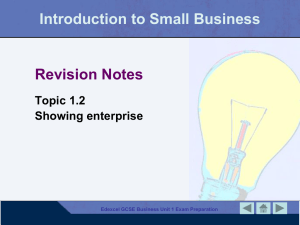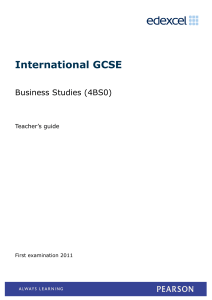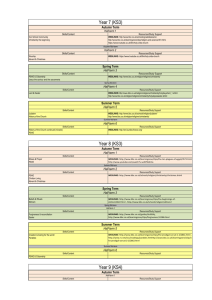Topic 1.1 Spotting a business opportunity
advertisement
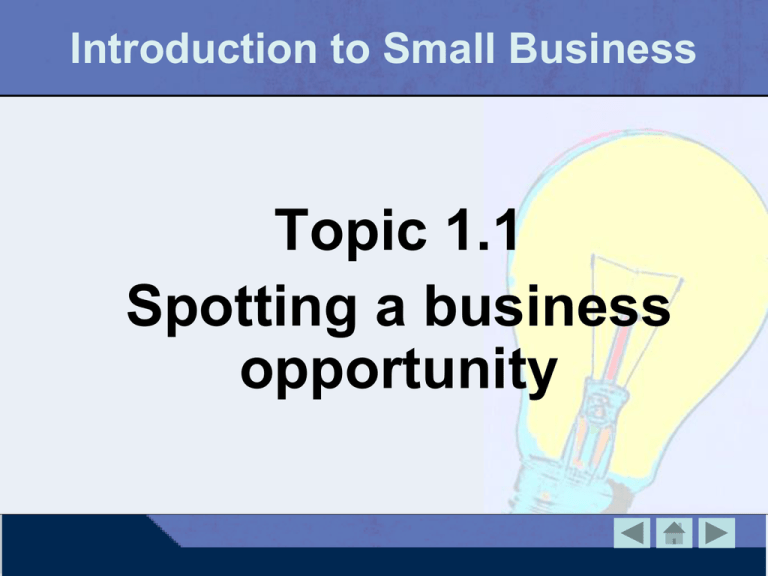
Introduction to Small Business Topic 1.1 Spotting a business opportunity Understanding customer needs What is a business? Businesses are organisations which produce goods and services. They do this by using resources such as raw materials, labour and machines. Businesses buy the goods and services they need from suppliers. They sell their own products to customers. Edexcel GCSE Business Unit 1 Exam Preparation suppliers buy from Businesses sell to customers What is a business? Terms you need to know: • Supplier – a business which sells (or supplies) products to another business. • Customer – any person or organisation which buys or is supplied with a product by a business. • Consumer – the person who ultimately uses (or consumes) a product. • Markets – where buyers and sellers meet to exchange goods and services. • Goods – physical, tangible products. • Services – intangible products. • Product – a good or service provided by a business to customers. Types of market research Terms you need to know: • Primary research – the gathering of new information, called primary data, which has not been collected before. • Secondary research – gathering information which has already been collected, such as sales records, government statistics and newspaper reports. • Qualitative data – information about opinions, judgements and attitudes. • Quantitative data – data that can be expressed as numbers and can be statistically analysed. Types of market research Market reports Surveys Internet sources Government statistics Local newspapers Information from market research groups Questionnaires Edexcel GCSE Business Unit 1 Exam Preparation Direct customer contact • A way of gaining market knowledge. • Involves meeting and speaking with customers to help understand exactly what they want. • Products and services can be developed to meet customer needs. • Direct customer contact is achieved by surveys, focus groups and through customer feedback exercises. Market Segments A group of customers with similar characteristics and buying habits. Markets can be segmented in many ways, as shown below: Market segments Age Gender Income Area Ethnicity Religion Socioeconomic Market mapping What is a market map? A diagram that shows the range of possible positions for two features of a product. In this example, price and quality are considered. Other features might include size, range of products, number of outlets and so on. Edexcel GCSE Business Unit 1 Exam Preparation Analysing the competition Competition – businesses which sell and/or produce similar products and target similar customers. Entrepreneur – person who owns and runs their own business and takes risks. In starting a new business, entrepreneurs need to know about the competition. As part of the planning for a new business, it is a good idea to draw up a list of criteria which can be used to judge potential competitors. It is also important to identify competitor strengths and weaknesses to see if a gap in the market can be seen. Edexcel GCSE Business Unit 1 Exam Preparation How to judge competitors Selling experience After-sales service Price Brand image Quality Suppliers Product range Business offering Edexcel GCSE Business Unit 1 Exam Preparation What is added value? Added value – the difference between what a business pays its suppliers, and the price it is able to charge for its product or service. Small businesses often have to work hard to add value. A chocolate producer has to compete against established brands, such as Cadbury’s and Nestle. By being able to add value to its product a business increases revenue on each sale. This could be an important way of ensuring survival. Edexcel GCSE Business Unit 1 Exam Preparation What is added value? There are various sources of added value for a business: Sources of added value Branding Design Unique Selling Point Quality Convenience Revision tip Think of a mnemonic to help remember this list. For example, ‘Big Dog Upsets Queen’s Cat’. Edexcel GCSE Business Unit 1 Exam Preparation Options for starting a business What is a franchise? One option for starting a new business is as a franchise. This is where an established business sells the right to trade under its name. Examples of franchises include Toni &Guy, Starbucks and BSM. The franchisee is the person or business buying the right from the established business. The business that gives the right to sell its products is the franchisor. Edexcel GCSE Business Unit 1 Exam Preparation Franchises Advantages and disadvantages as a start-up option Advantages of operating as a franchise • Training provided by the franchisor • Equipment provided • Established brand name • Back-up services, e.g. loans, insurance, advice • Expensive initial investment – and monthly costs Disadvantages • Less control for the franchisee of operating as a • No guarantee that franchises will be successful franchise • Uncertainty – franchise can be ended by the franchisor Edexcel GCSE Business Unit 1 Exam Preparation Location, location, location Why is location important? • All the good work on developing an idea, carrying out market research and arranging finance might be undone if the location is wrong. • For retail businesses the ideal location is likely to be where lots of passing trade exists. • For an online business, location close to customers is less important. • In short, the right location depends on the type of business. Edexcel GCSE Business Unit 1 Exam Preparation

